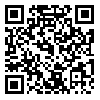Volume 7, Issue 2 (2016)
LRR 2016, 7(2): 143-163 |
Back to browse issues page
Download citation:
BibTeX | RIS | EndNote | Medlars | ProCite | Reference Manager | RefWorks
Send citation to:



BibTeX | RIS | EndNote | Medlars | ProCite | Reference Manager | RefWorks
Send citation to:
safari E. Phonological processes of Galeshi dialect: an optimality theory. LRR 2016; 7 (2) :143-163
URL: http://lrr.modares.ac.ir/article-14-2473-en.html
URL: http://lrr.modares.ac.ir/article-14-2473-en.html
PhD in General Linguistics
Abstract: (6351 Views)
The present research is aimed to analyze the phonological processes of Galeshi dialect such as; compensatory lengthening, deletion, lenition, raising and metathesis. The theoretical framework of the study is on optimality theory, and the dialectal data gathering has been via recording ten hours of speech together with the researcher's intuition as a native speaker. The data has been transcribed according to IPA (International Phonetic Alphabet) and the research method is descriptive- analytic. Accordingly, the phonological processes and compensatory deletion of /h/, /?/ in two- syllable words in CVC.CV (C) context leads to compensatory lengthening of vowel in first syllable; deletion of consonants /t/, /d/ as a second number of a consonant cluster or succession of consonants; deletion of coda voiced consonant after long vowels), lenition (change of /b/ to [v] and // to [X] ; raising (change of /e/ as a low vowel to [i] as a high vowel; metathesis (substitution of /r/ replaces /d/and /b/ in "madrese" and "kebrit" words and /s/ replaces /k/ in "taksi' word.(have been exemplified within the tables and analyzed in tableaus by the use of the constraint rankings in OT. The results depict deletion and insertion as the highest processed and metathesis as the lowest. Key words: Phonological Processes, Eshkevar Galeshi Dialect, Optimality Theory.
| Rights and permissions | |
 |
This work is licensed under a Creative Commons Attribution-NonCommercial 4.0 International License. |






